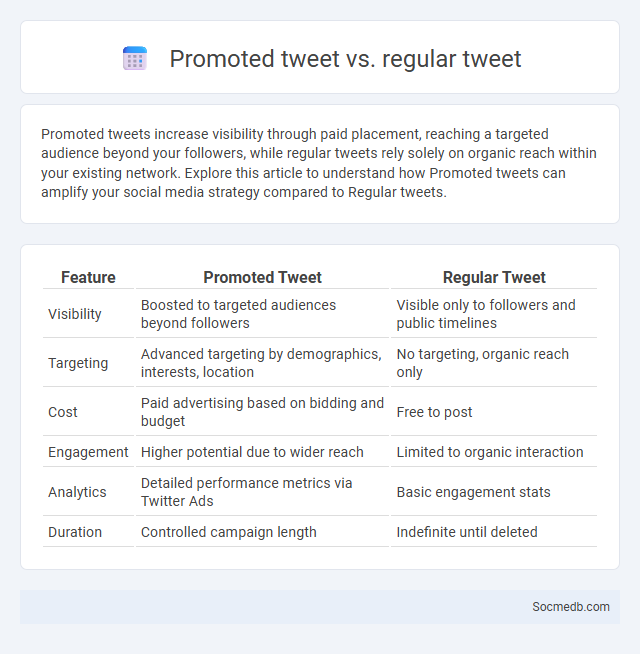
Photo illustration: Promoted tweet vs Regular tweet
Promoted tweets increase visibility through paid placement, reaching a targeted audience beyond your followers, while regular tweets rely solely on organic reach within your existing network. Explore this article to understand how Promoted tweets can amplify your social media strategy compared to Regular tweets.
Table of Comparison
| Feature | Promoted Tweet | Regular Tweet |
|---|---|---|
| Visibility | Boosted to targeted audiences beyond followers | Visible only to followers and public timelines |
| Targeting | Advanced targeting by demographics, interests, location | No targeting, organic reach only |
| Cost | Paid advertising based on bidding and budget | Free to post |
| Engagement | Higher potential due to wider reach | Limited to organic interaction |
| Analytics | Detailed performance metrics via Twitter Ads | Basic engagement stats |
| Duration | Controlled campaign length | Indefinite until deleted |
Introduction to Twitter Advertising
Twitter advertising offers businesses a dynamic platform to engage with targeted audiences through promoted tweets, accounts, and trends, maximizing brand visibility and interaction. By utilizing Twitter's precise targeting options, including demographics, interests, and real-time trends, your campaigns can reach relevant users effectively. Leveraging analytics and tailored ad formats allows you to optimize performance, driving higher conversions and enhancing overall marketing ROI.
Understanding Regular Tweets
Regular tweets on social media platforms like Twitter consist of concise messages limited to 280 characters, allowing users to share thoughts, news, or updates quickly. These tweets often include hashtags to categorize content and increase visibility among targeted audiences. Engaging regular tweets effectively involves clear language, relevant keywords, and timely topics to maximize reach and interaction.
What Are Promoted Tweets?
Promoted Tweets are paid advertising messages that appear in users' Twitter feeds, search results, or profiles to increase visibility and engagement. These tweets resemble regular content but are clearly labeled as "Promoted" to distinguish them from organic posts. Businesses and marketers use Promoted Tweets to target specific audiences based on demographics, interests, and behaviors, enhancing campaign reach and effectiveness.
Key Differences: Promoted vs Regular Tweets
Promoted Tweets are paid advertisements designed to reach a broader or targeted audience beyond your followers, increasing visibility and engagement through precise targeting options like demographics and interests. Regular Tweets are organic posts visible only to your current followers and rely on authentic engagement for amplification without any direct advertising cost. Understanding these key differences helps you strategically balance paid promotion with organic growth to maximize your social media impact.
Visibility and Reach Comparison
Social media platforms vary significantly in visibility and reach, with Facebook offering extensive audience targeting and Instagram excelling in visual engagement and younger demographics. LinkedIn provides high visibility for B2B content through professional networks, while TikTok's algorithm boosts organic reach via short, viral videos. Enhancing your strategy on the platform that aligns with your target audience maximizes your visibility and overall reach.
Engagement Metrics: Which Performs Better?
Engagement metrics such as likes, shares, comments, and click-through rates vary significantly across social media platforms, with Instagram often outperforming others in visual content engagement due to its user base and algorithm. Facebook excels in fostering community interaction through comments and shares, especially in groups and pages tailored to niche interests. Twitter's strength lies in real-time engagement and retweets, making it ideal for trending topics and quick information dissemination.
Cost Analysis: Promoted vs Regular Tweets
Promoted tweets typically incur a cost based on bidding models such as cost-per-click (CPC) or cost-per-impression (CPM), while regular tweets are free but offer limited organic reach. You can expect promoted tweets to deliver targeted visibility and engagement, which often translates to higher returns on investment when campaigns are optimized effectively. Understanding the cost differences and analyzing performance metrics is crucial for maximizing your social media marketing budget.
Use Cases for Each Tweet Type
Promotional tweets effectively boost brand awareness and drive product sales by highlighting special offers, new launches, or events. Engagement tweets foster community interaction through polls, questions, or user-generated content, increasing follower participation and loyalty. Informative tweets share industry news, tips, or educational content, positioning the brand as an authority and providing valuable insights to the audience.
Best Practices for Maximizing Impact
Optimizing social media impact requires consistent posting schedules tailored to peak audience engagement times across platforms like Instagram, Facebook, and LinkedIn. Leveraging data analytics tools such as Google Analytics and Hootsuite Insights refines content strategies by identifying high-performing posts and audience demographics. Incorporating multimedia elements like videos, infographics, and interactive stories significantly increases user interaction and share rates.
Choosing the Right Option for Your Goals
Selecting the ideal social media platform depends on your target audience, content format, and marketing objectives. For B2B engagement, LinkedIn offers robust networking and lead generation tools, while Instagram and TikTok excel in visual storytelling and brand awareness for consumer-focused campaigns. Evaluating platform analytics and aligning them with your business goals ensures maximum reach and effective audience engagement.
 socmedb.com
socmedb.com